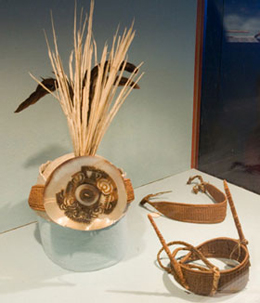Cook's Pacific Encounters is an online catalogue of the Cook-Forster Collection which is held at the Institute of Cultural and Social Anthropology, Georg-August University of Göttingen, Lower Saxony, Germany. The collection comprises more than 350 artefacts from 10 Pacific Island cultures in Polynesia, Melanesia, Micronesia and Pacific Americas, collected during three Pacific voyages of James Cook between 1768 and 1780.
The website was developed as a collaborative partnership between the university and the National Museum of Australia following the Museum's 2006 exhibition Cook's Pacific Encounters.

Viewing the collection in Göttingen, Lower Saxony, Germany
Some of the Cook-Forster Collection is on permanent display at:
Institute of Cultural and Social Anthropology
Theaterplatz 15
University of Göttingen
37073 Göttingen
Tel: +49 (0)551 / 39-7892
Fax: +49 (0)551 / 39-7359
Website: www.uni-goettingen.de/en/sh/28899.html
How the site was created
The collection is available for scholarly research by appointment. Contact the curator Dr Gundolf Krüger. Email: ethno@gwdg.de
The website was compiled from three printed catalogues:
- Cook's Pacific Encounters. The Cook-Forster Collection of the Georg-August University of Göttingen, National Museum of Australia Press, Canberra, 2006 (exhibition at the National Museum of Australia, Canberra, 1 July to 10 September 2006).
- Life in the Pacific of the 1700s - The Cook/Forster Collection of the Georg-August University of Göttingen, 3 vols, Honolulu Academy of Arts, Honolulu, 2006 (exhibition at Honolulu Academy of Arts, Hawaii, 23 February to 14 May 2006).
- James Cook: Gifts and Treasures from the South Seas (Gaben und Schätze aus der Südsee), The Cook/Forster Collection, Göttingen (Die Göttinger Sammlung Cook/Forster), Brigitta Hauser-Schäublin and Gundolf Krüger (eds), Prestel, Munich, New York, 1998.
The objects
The focus of the site is the list of 361 objects and their descriptions. The information about the objects includes:
- type category
- geographical region
- short description
- long description
- thumbnail image
- large image
- zoomified image (for five objects and the maps). Zoomify is a web-browser enhancement that enables a very large image to be displayed within your screen. You can zoom in and out and navigate around the images using the controls within the pop-up.
Note: the objects which cannot be definitively attributed to a defined geographical area are described as 'unknown'.
Long descriptions
Many of the long descriptions describe more than one object. To ensure that each object is represented by a high-quality image, we chose to repeat the long descriptions rather than bundle the images together.
The authors of the long descriptions are:
- Christian F. Feest (CF)
- Volker Harms (VH)
- Brigitta Hauser-Schäublin (BH)
- Inken Köhler (IK)
- Gundolf Krüger (GK)
- Ulrike Rehr (UR)
- Markus Schindlbeck (MS)
- Insa Wendt (IW)
Contextual resources
In addition to the objects, the website provides a number of contextual resources:
- background essays from the National Museum of Australia's exhibition catalogue
- detailed maps of Cook's Pacific voyages
- a consolidated list of references drawn from the long descriptions and the essays in the Background section of the website
- links to websites on Cook, Cook's voyages, Pacific history, Pacific anthropology
- teachers resources for secondary students.
Search function
The search page searches the object catalogue only. Search results are returned if the search text is found in the Title, Short description or Long description fields.
Navigation to all other material on the site is accessible from every page (eg background and resources). You may search these resources via the 'search this page' feature in your browser.
Disclaimer
While we have made every effort to ensure that the material on the site is accurate and up to date when published, you should exercise your own independent skill and judgment before relying on it. Links to other websites have been inserted for your convenience and do not constitute our endorsement of material at those sites, or any associated organisation, product or service.
Some material on this site may include the views of third parties. These do not necessarily reflect the views of the National Museum of Australia. The National Museum cannot verify the accuracy of information that has been provided by third parties.
Feedback
We welcome your feedback about this site. Email feedback@nma.gov.au